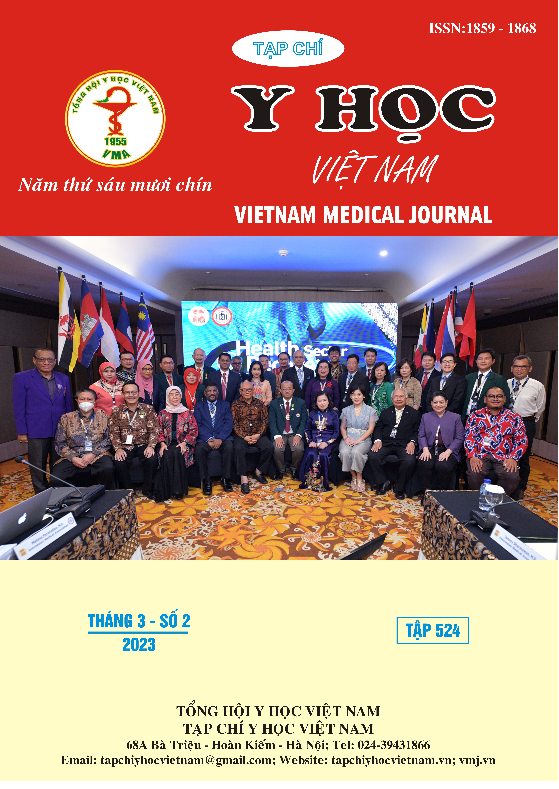CERVICAL LYMPH NODE METASTASIS AND RELATIVE CLINICOPATHOLOGICAL FACTORS IN THE FLOOR OF MOUTH CARCINOMA
Main Article Content
Abstract
Objectives: To evaluate cervical lymph node metastasis and its relationship with clinicopathological characteristics in patients with floor-of-mouth carcinoma. Patients and methods: A cross-sectional descriptive study on 48 patients with floor-of-mouth carcinoma without clinical lymph node metastasis who underwent extensive resection with selective cervical lymphadenectomy at National Cancer Hospital from 01/2015 to 01/2020. Results: In 48 patients studied, the mean age was 56.8 (41 - 75); male/female ratio = 7; most patients have a history of smoking and drinking alcohol; 29.2% of patients had midline-involved tumors; The most common tumor types are exophytic and ulcerative combined (45.8%); mean tumor size 2.13 ± 0.79cm. Most DOI >5mm; postoperative stage pT1,2 accounted for mainly (79.2%); the mean number of removed lymph nodes was 14.0 ± 7.1; The lymph node metastasis rate was 22.9%. Lymph node metastasis rate was higher in tumors >2cm compared with ≤2cm (36% vs 8.7%; OR = 2,593, p=0.025), DOI >5mm vs ≤5mm (42.1% vs. 8.3%; OR = 8, p = 0.044). The lymph node metastasis rate increased gradually by stage pT1, pT2, and pT3 (6.7%, 21.7%, and 50% respectively) with p=0.041. Age, gender, morphology, and tumor location are not associated with lymph node metastasis rate. Conclusions: Floor of mouth cancer often metastasizes to lymph nodes early. Cervical lymph node metastasis was associated with tumor size, depth of invasion, and postoperative stage.
Article Details
Keywords
floor of mouth cancer, cervical lymph node metastasis
References
2. Văn Quảng L, Quốc Duy N, Thế Đường L, Xuân Quý N. Đánh giá tình trạng di căn hạch cổ và mối tương quan tới đặc điểm bệnh học ung thư khoang miệng. Vmj. 2021;500(1). doi:10.51298/vmj.v500i1.338
3. d’Alessandro AF, Pinto FR, Lin CS, et al. Oral cavity squamous cell carcinoma: factors related to occult lymph node metastasis. Braz J Otorhinolaryngol. 2015;81(3):248-254. doi:10.1016/j.bjorl.2015.03.004
4. Hicks WL, Loree TR, Garcia RI, et al. Squamous cell carcinoma of the floor of mouth: A 20-year review. Head Neck. 1997;19(5):400-405. doi:10.1002/(SICI)1097-0347(199708)19:5<400::AID-HED6>3.0.CO;2-3
5. Saggi S, Badran KW, Han AY, Kuan EC, St. John MA. Clinicopathologic Characteristics and Survival Outcomes in Floor of Mouth Squamous Cell Carcinoma: A Population-Based Study. Otolaryngol Head Neck Surg. 2018;159(1):51-58. doi:10.1177/0194599818756815
6. Künzel J, Psychogios G, Koch M, Mantsopoulos K, Kapsreiter M, Iro H. Results of treatment for pT1/pT2 carcinomas of the floor of mouth. Acta Oto-Laryngologica. 2013;133(9): 1000-1005. doi:10.3109/00016489.2013.796090
7. Suzuki M, Suzuki T, Asai M, et al. Clinicopathological factors related to cervical lymph node metastasis in a patient with carcinoma of the oral floor. Acta Oto-Laryngologica. 2007;127(sup559):129-135. doi: 10.1080/03655230701600020
8. Yamazaki H, Inoue T, Yoshida K, et al. Lymph node metastasis of early oral tongue cancer after interstitial radiotherapy. International Journal of Radiation Oncology*Biology*Physics. 2004;58(1):139-146. doi:10.1016/S0360-3016(03)01459-7
9. Lloyd S, Yu JB, Wilson LD, Judson BL, Decker RH. The Prognostic Importance of Midline Involvement in Oral Tongue Cancer. American Journal of Clinical Oncology. 2012; 35(5):468-473. doi:10.1097/ COC.0b013e3182195619


